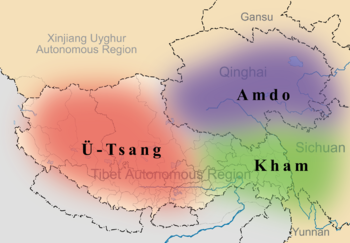- Ü-Tsang
-
"Tsang" redirects here. For the Chinese surname, see Zeng.
Ü-Tsang (Tibetan: དབུས་གཙང་, Wylie: Dbus-gtsang; simplified Chinese: 卫藏; traditional Chinese: 衛藏; pinyin: Wèizàng), or Tsang-Ü, is one of the three traditional provinces of Tibet, the other two being Amdo and Kham. Geographically Ü-Tsang covered the central and western portions of the Tibetan cultural area, including the Tsang-po (Gtsang-po) watershed, the western districts surrounding and extending past Mount Kailash, and much of the vast Chang Tang (Byang-thang) plateau to the north. The Himalayan range defined Ü-Tsang's southern border. The present Tibet Autonomous Region corresponds approximately to what was ancient Ü-Tsang and western Kham.
Ü-Tsang was formed by the merging of two earlier power centers: Ü (Dbus) in central Tibet, controlled by the Gelukpa (Dge-lugs-pa) sect of Tibetan Buddhism under the early Dalai Lamas, and Tsang (Gtsang) which extended from Gyantse (Rgyang-rtse) to points west, controlled by the rival Sakyapa (Sa-skya-pa) sect. Military victories by the powerful Fifth Dalai Lama consolidated power over the combined region in the 17th century.
Ü-Tsang is the cultural heartland of the Tibetan people. Successive Dalai Lamas have ruled Tibet from the Potala and Norbulingka palaces in Lhasa. Jokhang Temple, perhaps the most holy temple in Tibetan Buddhism, is also located there. The Tibetan language dialect spoken in Lhasa is used as a lingua franca in Ü-Tsang and the Tibetan Exile koine language is also based largely on it.
Front and Back Tibet
Tsang, whose largest cities are Gyantse and Shigatse, near where the Panchen Lama has his traditional seat at Tashilhunpo Monastery, was designated on maps of the Qing Dynasty as "Back Tibet", while Ü, where the Dalai Lama has his seat at Lhasa, was designated "Front Tibet". This division was an artificial construct of the Chinese and had no currency within Tibet where the Dalai Lama exercised effective rule over both Tsang and Ü. An attempt had been made in the 18th century during the reign of the Yongzheng Emperor to split Tibet by offering the Panchen Lama dominion over Tsang, but the expansive offer was declined, the Panchen Lama only accepting a small portion of the offered territory.[1] Later attempts, during the period 1906-1913 and in 1950, by the Panchen Lama to resurrect a separate Back Tibet over which he would have dominion were rejected by the Chinese.[2]

Tsong people
Tsong people are divisional Limbu clans in Sikkim. Originally natives from the U-Tsang territory of Tibet. They migrated from Sjiyatse, Penam, Norpu, Giengtse etc. of the Tsang province of Tibet. They followed Guru Matog Lama, a major Buddhist influence on the Limbus and settled in Sikkim. In Nepal and eastern Limbu settlements, these words are used by Limbus to describe Sikkimese Limbu clans.
Notes
- ^ Goldstein, Melvyn C. (2007). A history of modern Tibet, Volume 2: The Calm before the Storm: 1951-1955. University of California Press. p. 266 and 267. ISBN 978-0-520-24941-7.
- ^ Goldstein, Melvyn C. (2007). A history of modern Tibet, Volume 2: The Calm before the Storm: 1951-1955. University of California Press. pp. 266–267 and 277–286. ISBN 978-0-520-24941-7.
Categories:- Tibet
- Subdivisions of Tibet
Wikimedia Foundation. 2010.

